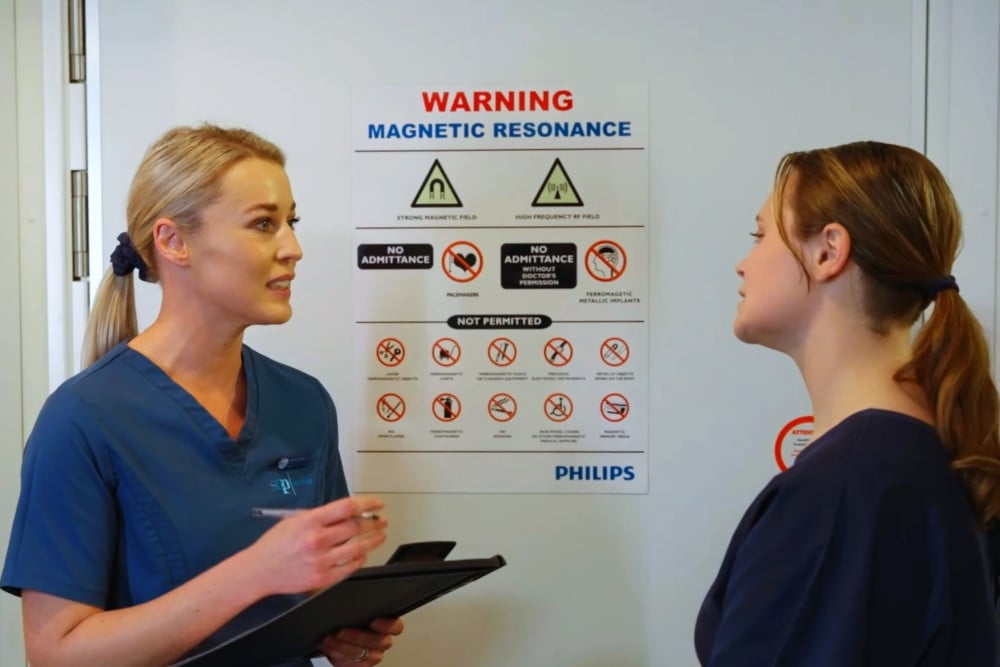A patient and caregiver guide to MRI safety
Have you seen recent news about a New York patient’s husband who passed away during an unusual MRI safety breach? You may be wondering if this is really possible. The answer is yes – but only in very rare circumstances after stringent MRI safety measures were not adhered to.
MRI is among the most advanced medical imaging technologies available. It can give doctors very detailed views of the soft tissues in the body and doesn’t use ionizing radiation like X-rays and CT scans do. That doesn’t mean it’s completely risk-free. In fact, if you’ve ever had an MRI scan, you’ll know that it comes with a rather detailed safety questionnaire.
This is because an MRI machine contains a powerful superconducting magnet. It can attract ferromagnetic metal objects such as hospital beds, wheelchairs, oxygen tanks, tools, and jewellery with such force that it may not be possible to get them unstuck without painstaking, specialised intervention. If a person gets caught between the magnet and the metal object, it could be very dangerous and even fatal.
Fortunately, radiology personnel are trained and experienced in maintaining strict safety protocols around their equipment, and MRI accidents are exceedingly rare. In this article, we explain to patients and caregivers of the precautions we take to ensure safety in the MRI room.
The basics of MRI and its magnetism
MRI stands for magnetic resonance imaging. The term refers to the strong magnetic fields that, together with high-frequency radio waves, create detailed digital images for radiologists to report on.
Most MRI machines range in strength from 1.5 Tesla to 3 Tesla (Tesla is a measuring unit for magnetism). Compared to everyday refrigerator magnets — which are about 0.001 Tesla in strength — MRI magnets are over a thousand times stronger. These powerful magnets can pull in certain metal objects, such as tools or oxygen tanks, from several meters away. If these objects enter the MRI room by accident, they can become dangerous projectiles, capable of causing serious injuries or even death. This is why strict safety precautions are so important.
How do radiology practices ensure MRI safety?
Radiology departments are required to adhere to strict rules when installing and operating MRI equipment. These are some of the safety precautions we take to ensure the safety of our patients and staff:
- Metal-free environment: MRI rooms are kitted out with MRI-friendly materials, and all equipment in the room is specially manufactured to be safe for use near the magnet.
- Clear markings and warning signs: Clearly marked boundaries and warning signs help to keep patients and staff aware of the necessary safety measures.
- Restricted access: Only trained staff, patients, and caregivers are allowed near MRI rooms.
- Strict screening procedures: All patients and caregivers are required to answer a series of questions before they are allowed to enter the MRI room. This is to ensure they don’t have metal objects on or in their body that could pose a health or safety risk.
- Staff training: Radiographers undergo extensive training before operating MRI equipment. This training includes robust safety training that they learn to uphold at all times.

What should I know if I’m a patient or caregiver?
If you have an MRI scheduled or will accompany a child to their scan, you’ll need to answer a detailed questionnaire before being taken into the MRI room. Some of these questions may also be asked when you make a booking, to ensure you are eligible to get an MRI scan.
The questionnaire includes whether you have:
- any dangerous objects such as weapons or tools with you;
- any metal-containing clothing items or jewellery on your body;
- a pacemaker;
- an aneurysm clip;
- an artificial heart valve;
- a Vena Cava filter;
- any prosthesis;
- cochlear implants or hearing aids;
- shrapnel anywhere in the body;
- a neurostimulator;
- any other implant such as screws, plates, rods, or joint replacements.
Some models of medical devices are MRI-compatible. However, it’s critical that we confirm this before the scan can take place.
Other safety considerations
- Heating risk: Conductive materials on clothing or in body piercings may pose a heating risk.
- Contrast agents: For some MRI procedures, we may need to administer a contrast agent to increase visibility on your scan. If this is the case, you’ll be screened for potential allergic or kidney risks.
- Pregnancy: Although non-contrasted MRI is considered safe during pregnancy, it is usually avoided during the first trimester unless critical for the patient’s health.
- Claustrophobia and noise sensitivity: MRI machines usually make loud noises, which is why we provide ear protection for patients undergoing scans. Some patients with claustrophobia may also experience anxiety while in the MRI “tunnel”, in which case sedation could be considered.
- Emergency procedures: MRI machines often have stop mechanisms to help staff manage the situation in case of a life-threatening emergency.
Understanding MRI safety is essential for your peace of mind. While MRI is a powerful and generally safe diagnostic tool, its strong magnetic fields mean certain precautions are absolutely necessary. By following established safety protocols, answering screening questions honestly, and relying on the expertise of trained radiology staff, you can feel confident that your MRI scan will be both safe and effective.
• The article is intended to create awareness and none of the information it contains should replace the need for seeking personal advice from a qualified medical practitioner.
• Apart from selected screening examinations, all radiology procedures are performed upon referral from a qualified medical professional.




